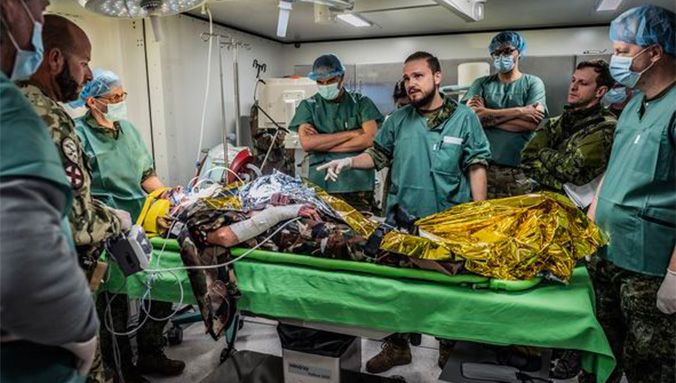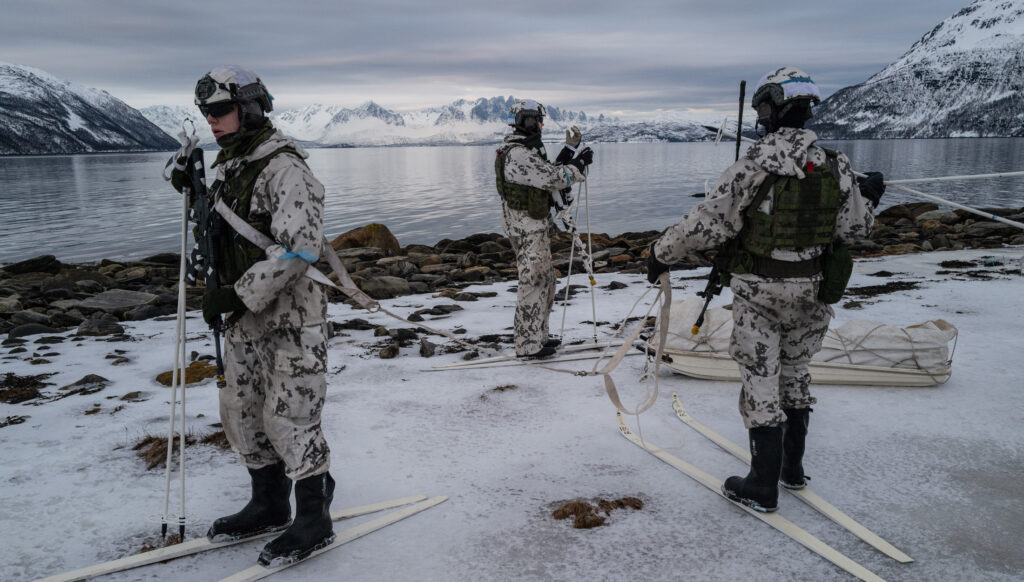
NATO’s 75th Anniversary Summit in Washington, D.C. recently ended with a commitment from its members to reach the 2 percent GDP target for defense spending, although the timeline to achieve this goal may vary among some members. As of this year, 23 out of 32 members will reach this target. This spending level will have an impact by generating jobs in developed economies, which is the need of the hour.
While this investment will benefit the defense sector the most, allied sectors such as technical textiles and infrastructure, will also get a needed boost. Bolstering the defense and manufacturing sectors will enhance transatlantic trade curbing the influx of cheaper components and “made-up” high-tech products from China.
Advanced textiles that have important roles in defense include health care and environmental protection. Specifically, textiles contribute to a range of product needs including ballistics protection and soft armor, filters, parachute fabrics, industrial workwear, thermal control, CBRN (chemical, biological, radiological and nuclear) countermeasures, fluorescent fibrous materials, hygiene and medical products, among others.
Funding support
There is a synergistic relationship between defense agencies and the textile industry. Major technologies that deal with lifesaving, health care and environmental concerns have received funding support from the defense sector. Technologies like meltblown and electrospinning that are important components of PPE and filters were supported by the U.S. Dept. of Defense.
Small-to-medium enterprises (SMEs) enjoy support from the defense sector through funding mechanisms such as Small Business Innovation Research (SBIR) and Small Business Technology Transfer (STTR). Federal agencies such as the National Science Foundation and the Dept. of Defense are supporting research in fibrous materials by funding major initiatives, such as has been the case with the Advanced Functional Fabrics of America (AFFOA).
The U.S. is not alone. Recently, India’s Defense Research Development Organization is funding a project on smart textiles embedded with graphene for Alohatech Pvt. Ltd.
Sourcing and investing
According to some military experts the world is facing the most dangerous times since WW II. While this may sound like hyperbole, the war in Ukraine –underway now for more than two years—is a clear indication of this situation. It is important for governments to invest in the advancement of the defense sector so that countries are prepared, and self-defense is strengthened.
Speaking at the recent North Atlantic Alliance forum of NATO, President Biden said that NATO members are expanding their industrial base and capacity. Highlighting the U.S. government’s investment of about $30 billion in defense production in 35 states, Biden says that members are developing plans for domestic production, so that the defense sector is competitive.
Supporting the above view, Tony Fragnito, president and CEO of the Association of the Nonwoven Fabrics Industry (INDA) says, “INDA believes there are positive cost, performance and national security implications to sourcing engineered materials, and specifically nonwoven compositions, from North American sources.”
Investments in the defense industry network strengthen national defense, international trade and help with economic growth. The 2024 NATO Summit has released a unified message on the need for member countries to commit to 2 percent of GDP for defense. The recently elected Prime Minister Keir Starmer of the U.K. committed to increase defense spending to 2.5 percent of its GDP. While there are issues regarding Canada’s defense spending level, which is now at 1.37 percent of its GDP, Canada has committed to reach the 2 percent target by 2032.
Given the importance of preparedness for current and future threats, continuous investment in research and manufacturing must be enhanced. These commitments from NATO members will spur growth in the advanced textiles sector.

Pro’s and concerns
Collaboration with various defense and other government agencies is a win-win process offering both industry participants and government entities the means to get maximum output from investments.
Amit Kapoor, president of Fredericksburg, Va.-based First Line Technology, says, “Collaboration with defense and other government agencies helps spur innovation for product development for commercial applications. The government has always been a great innovation partner for industry through Cooperative Research and Development Agreements (CRADAs) and commercialization licensing agreements.”
Kapoor adds, “It’s not as easy as just finding a champion in the government who thinks your product is a good idea. There needs to be a requirement or a “need” for your respective product. A great starting point is for businesses to attend innovation-related events and conferences that are held by associations like INDA or the government itself.”
“The most essential one in creating collaborative relationships is to establish credibility” says Weisbart, vice president of AR TECH, Fontana, Calif., “The commitment to quality is backed by our knowledge of the resources and designs that can address the markets’ requirements for fabrics, or flexible composites, and should be demonstrated by examples of what we have achieved.”
To enable more collaboration and contracts, Fragnito says, “It is critical to be prepared to educate government agencies on the unique attributes and values that nonwoven engineered materials provide.” However, given the complexities involved with government bids, Fragnito adds, “I wish, but do not expect, federal procurement could be more focused on partnering with industry to provide solutions which foster innovation and support reliable demand.
“The reality is that federal procurement is a challenging “game” for many in our industry since the focus is often on price and exclusive awards vs. a more holistic approach to supporting industry and supply chains.”
Dr. Narasimhan Srinivasan, president of Chennai, India-based Asthagiri Herbal Research Foundation, which develops chemistry formulations for advanced materials, says that collaborations and funding requests with government agencies will be successful if the companies comply with procedural requirements in the process. He adds that project and consumer costs are important.
“In spite of making a safe product, I am unable to entice the consumer to the premium price,” Dr. Srinivasan says. “When it comes to the question of economics, the smallest price is the choice of consumer.”
This view impacts the advanced textiles industry, in particular, as this sector is dependent on R&D, which involves added costs. Its smaller market size compared to commodity textiles also contributes. As many advanced products involve efforts to save lives, governments should be cognizant of the necessary costs involved and support research and product development.
Drawing on his experience with Indian defense agencies, Ganesh Srinivasan, CEO of Bengaluru-based Resil Chemicals says, “Commercializing new textile products in the defense sector faces several challenges. Developing new specifications for textile products with advanced functionalities is often not rewarding for private companies, as these specifications are eventually opened for competition. This makes it difficult for private innovators to recover R&D time and costs.”
Investment in textile innovation
Developments initially intended for the defense sector spill over into other sectors such as health care, communication and social sciences. Next generation medical drapes, bandages and sutures benefit the wider medical market and can have dual use. In addition to mandatory medical functionality requirements, defense agencies should support those programs that focus on sustainability goals, as well.
At the intersection of defense and advanced textiles there are opportunities in using sustainable raw materials and processes. To move in this direction, more investments in research on advanced materials used in defense and industrial products are needed. Sustainable materials such as cotton and regenerated fibers have penetrated products such as base layer garments and battle dress garments. Cost-effective ways of adding necessary functionality, such as breaking down toxins, offer scope, and hence multidisciplinary approaches are needed.
Military product development
While the functionality may be a barrier for the penetration of currently available sustainable materials, there are opportunities in areas that support war theaters. The transport of oil for fueling military vehicles is a critical operation in war theaters, which leads to oil spills. Cellulosic fibers like cotton have been shown to absorb oil and the product does not lead to environmental problems such as microplastics. Industry – academic partnerships have resulted in the development of cotton-based oil absorbents.
Not only the project has been supported by U.S. cotton producers, but it has also led to international collaboration. Aruppukottai, India-based Jayalakshmi Textiles has collaborated with the Nonwovens and Advanced Materials Laboratory at Texas Tech University. The product has applications in domestic, industrial and defense markets.
“Lab to Lifesaving” is the motto of First Line Technology, which has been involved with government and academia in developing products for military and local agencies. “We at First Line have done this successfully a couple of times with FiberTect (dry decontamination), Dahlgren Decon (reactive decontamination) and recently a cooling system called Arm Immersion Cooling System by the U.S. Army. All of these were licensed or developed with the government.”
Resil and its subsidiary N9 World Technologies Private Limited (N9WTPL) have developed N9 PURE SILVER, which is a patented, novel silver product developed through collaboration with research institutes that enhances the hygienic prerequisites of military wear, thereby improving comfort. According to Resil, military uniforms and jackets treated with N9 Pure Silver™ keep odor-causing bacteria at bay, providing better hygiene and comfort for the wearer.
A way forward
Based on the outcomes from the recent NATO summit, it is evident that collaboration, collective strength and sharing of resources among allies are valued in the defense arena. The advanced textiles sector can benefit from the co-development and co-production strategies followed by the defense sector to speed up innovation and manufacturing, while reducing cost.
The technical textiles industry is facing a bright future as its contributions in the defense, health, and environmental protection areas will get a boost via the increased investments in developed economies. Effective communication happens—and new innovations can get to market more quickly—when active engagement among industry, academia and research organizations is encouraged.
Ganesh Srinivasan highlighted the importance of engaging with stakeholders to move the industry forward, saying, “Specialized training, leveraging government schemes and active participation in industry associations build strong networks. Ensuring high-quality standards and effective communication of product benefits, along with showcasing successful collaborations, will foster mutual growth and success.”
Fragnito says, “Collaboration with academia is critical for focusing research efforts and dissemination of the basic research findings in the material sciences.”
Professional associations have a role to play in helping their members to enhance their technical and marketing capabilities. “One thing that would be great is if our ATA would identify our capabilities as members more effectively and provide resources to open doors to opportunities to grow our markets,” says Bud Weisbart.
Given the concerns highlighted by many industry leaders, governments should find a way to collaboratively work with SMEs and industry by cutting the bureaucracy, as well as providing support for R&D, skill enhancement and marketing.
In the words on U.S. Secretary of Defense Lloyd Austin III, delivered at the NATO summit, “As a soldier, the last thing that you want to do is to fight alone,” which underscores the importance of strategic and effective collaboration.
Dr. Seshadri Ramkumar is a professor in the Department of Environmental Toxicology and The Institute of Environmental and Human Health, Texas Tech University, and a regular contributor to Textile Technology Source.
 TEXTILES.ORG
TEXTILES.ORG


